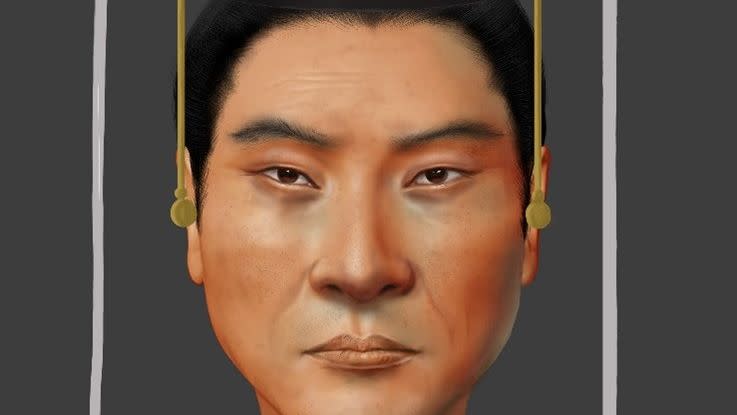Scientists Reconstructed the Real Face of an Ancient Chinese Emperor

"Hearst Magazines and Yahoo may earn commission or revenue on some items through these links."
Over the years, scientists have leveraged DNA and bone analysis to reconstruct the faces of ancient peoples and famous figures.
Scientists from Fudan University are now adding another historical leader to the mix—Emperor Wu, who ruled the northern Zhou dynasty in the 6th century CE.
Locked away in 1 million single-nucleotide polymorphisms, scientists found DNA information related to the skin tone and hair color of the emperor, and recreated his face by merging the data with an accurate reconstruction of his skull.
One of the most frustrating things about studying history is its stubborn opaqueness. While scholars of 20th century events have (at the very least) black-and-white photos and films to help illuminate the past, putting a face to the name of ancient rulers was the sole province of artisans for a long time. The abilities of sculptors and painters were once the only ways to capture the great figures of history.
But in the 21st century, historians have new tools for fleshing out history. In recent years, scientists have reconstructed the visage of Bonnie Prince Charlie (the grandson of England’s James II, who got the boot during the Glorious Revolution), Robert the Bruce (one of Scotland’s most legendary kings), and even Jesus Christ (who probably needs no introduction). Now, using DNA data and a meticulous analysis of a near-complete skull, scientists from Fudan University in Shanghai have created a digital recreation of Chinese Emperor Wu, who ruled the northern Zhou dynasty during the 6th century. The results were published today in the journal Current Biology.
“Our work brought historical figures to life,” Fudan University’s Pianpian Wei, the paper’s co-author, said in a press statement. “Previously, people had to rely on historical records or murals to picture what ancient people looked like. We are able to reveal the appearance of the Xianbei people directly.”
To complete this historical recreation, Wei’s team recovered over 1 million single-nucleotide polymorphisms (SNPs) after the discovery of Wu’s tomb in 1996. SNPs are the most common genetic variation among people, and occur once in every 1,000 nucleotides—an organic molecule formed from DNA. This means that every person contains between four to five million of these SNPs, and while some of these variations have no effect on human health, others can greatly impact a person’s predisposition to certain diseases or drug response. Crucially, some of these SNPs contained data related to the skin tone and hair color of Emperor Wu, who was ethnically Xianbei—a nomadic people group that populated the eastern Eurasian steppe (modern-day Mongolia and north/northeastern China).
Wei’s team then combined this data with a digital reconstruction of Emperor Wu’s nearly complete skull, and created an image that revealed features similar to people from present day Northern and Eastern Asia—a physical description that runs counter to some scholarly accounts of the Xianbei people.
“Some scholars said the Xianbei had ‘exotic’ looks, such as thick beard, high nose bridge, and yellow hair,” Fudan University’s Shaoqing Wen, who was also involved with the study, said in a press statement. “Our analysis shows Emperor Wu had typical East or Northeast Asian facial characteristics.”
Along with Wu’s appearance, the team also revealed new details about the emperor’s death—he died young at the age of 36, under some musings of potential poisoning. However, in congruence with historical accounts that describe the emperor as “having aphasia, drooping eyelids, and an abnormal gait,” the DNA analysis reveals that emperor was at an increased risk of stroke, which would explain the listed symptoms.
While a stroke might’ve done him in some 1,500 years ago, thanks to modern DNA technology, another long dead leader lives once again.
You Might Also Like

